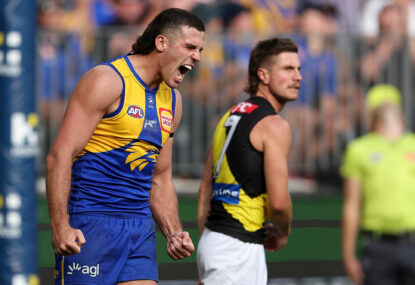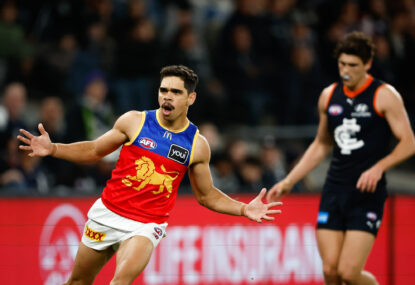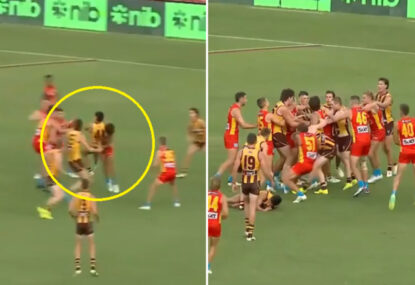The AFLW’s back, which means a first week of scratchy skills, awful weather, lopsided results and silly controversies around silly people saying silly things on social media.
First, the weather. Fact is, the women’s game will always be much more affected by bad weather than the men’s.
Partly this is because the women are playing on unprotected grounds with no stadiums, while the howling gales we saw at Casey Fields, Vic Park and Fremantle Oval are barely felt in the fortress of the MCG or Optus Oval, let alone indoors at Docklands.
But mostly, the women simply don’t kick it as far, and when they do they often hang it high in the air so the wind grabs it, being mostly unable to penetrate low and flat.
And then when it rains, well, we saw the result at Blacktown, where GWS won by nine points to eight against the Gold Coast in what has become a tradition of Sydney games being played in crazy weather.
Obviously a group of players often struggling to one-touch the ball in the dry are always going to barely score in torrential wet, and people suggesting there’s something wrong with this don’t have their heads screwed on properly.
And no, playing on a smaller ground would only make for more congestion. Anyone who actually watches AFLW has seen countless times when the ball is stuck in the forward 50 for ten minutes with barely a score – lots of players crammed into a smaller space makes footy worse, not better.
The answer to lower scores is footspeed and one-touch skills in all conditions, and that will only come with time, new athletes entering the game, and longer seasons so that the season’s not nearly over by the time the players’ skills start to click.
This latter point is important, and needs to be remembered every time Round 1 rolls around – the difference between Round 4 skills and Round 1 skills is always large, thanks to the women playing effectively ten months off and two months on. You’d be pretty rusty too, at anything, if you hadn’t done it at a high level for ten months.
Practise is not matchplay, and if Round 1 proved anything it’s that state leagues sure as heck aren’t AFLW (take note, Richmond VFLW fans).
It would be interesting to speculate how much higher the AFLW average scores would be if the weather were better, or the grounds more protected (my guess is about 30 per cent) but it’s not going to happen so let’s just get on with it.

Anne Hatchard in action for the Crows. (AAP Image/Darren England)
Expansion teams
Richmond actually looked a little better than I’d expected, despite getting thumped by Carlton 14 to 48. Their backline was heroic, repelling attack after attack, tackling hard and reducing the Blues’ forward-fifty efficiency to 41 per cent, and much lower than that in the earlier stages.
Akec Makur-Chuot, Laura McClelland, Sarah Sansonetti and Gabrielle Seymour all showed the Tigers have young or inexperienced talent to work with across the backline, and can look forward to exciting things in the future.
The forward line showed less, but most of that, as I said would happen in my season preview, was the inability of the other Tigers to get them the ball.
Richmond’s main problem was the midfield and particularly the ruck, where they got smashed in hitouts 12-37, and clearances 12-27. Monique Conti tried hard with 13 disposals but she’s not a big body and needs strong help around her to win the hard ball against the competition’s better midfields.
Katie Brennan struggled with just ten disposals, and the Tigers demonstrated once again why expansion teams recruiting big-name forwards instead of midfielders is a mistake.
The Saints had a better start despite being beaten four goals to one in the first quarter, showing plenty of dash from Nat Exxon, Molly McDonald and the crazily exciting Georgia Patrikios.
But then Peta Searle decided she needed to slow the game down, playing multiple players behind the ball and crowding the stoppages. It certainly stopped the Bulldogs, but it also stopped the Saints. Given St Kilda were already 20 points down and needed to score to win, this was as good as running up the white flag at quarter-time, and turned an entertaining game into an ugly one.
If the Saints keep running in future games, and let their excitement machine Patrikios off the leash, they’ll certainly lose some games by large margins, but they’ll also learn to play the style that could take them to the finals in a few years. If they decide to clog it up and slow it down, they’ll lose games by fewer points, but will never learn how to make a final, let alone win one.
The Suns looked wet. That’s it. You can’t really tell how good a team is after watching them play in those conditions. If it was dry they might have lost by thirty, or they might have won, you just can’t tell.
They’re tough, they tackle hard, and they were unlucky to lose by a point. Next week against fellow expansion team Richmond we’ll get to see what they can really do, but for now that’s all I’ve got.
Despite the 38 to 11 scoreline, the Eagles did pretty well. They won the clearances 27 to 20, had only one less inside fifty (22-23), and had more tackles (61-52). Dana Hooker and Emma Swanson were terrific with 18 disposals each, well supported by Imhara Cameron with 13 and lots of dash.
Young Mikayla Bowen had eight disposals and ten tackles, and McKenzie Dowrick’s huge left boot is going to be vital moving the ball out of defence into this season’s howling gales, as she’s possibly the only player in the AFLW who can actually pinpoint targets from fifty metres.
West Coast’s problem is that they just can’t turn possession and forward thrusts into goals. Forward Grace Kelly left the ground with what looked like a hamstring injury. She showed some real promise, but will now likely miss a few games, which in AFLW terms means half the season.
It’s unlikely that the Eagles will be able to solve their scoring problem this season, but as a supporter the prospect only makes me shrug. Midfields matter most, the Eagles’ mids looked good for a first game, and the backline wasn’t too shabby. It’s something to work on for the next few years.
Building finals success, for all this year’s expansion teams, is going to be at least a two-year deal and probably longer.

Georgia Patrikios. (AAP Image/Michael Dodge)
Shocks and surprises
Adelaide losing isn’t really a shock. When I picked them to win the final I was doing so on the understanding that they’d have Erin Phillips and Chloe Scheer at least in the forward line, plus Ruth Wallace, Jo Metcalfe, Deni Vanhagen and Sophie Li.
But the AFLW is all about stringing together chains of possession, and not only were those six quality players out, they were replaced by six whose skills aren’t nearly as good. Suddenly the number of Crows on the field whose skills get shaky under pressure went from a handful to nearly half the team, and those previously strong possession chains began breaking down.
Furthermore, the Crows play a possession-heavy style that requires a high skill-level to execute. In this game, they had more disposals (249-216), but lacked the skilled players to make it work.
An AFL team might have the depth to absorb this many injuries, but AFLW teams can’t, not even Adelaide. Add Chelsea Randall and Hannah Martin’s ACLs, and this current Crows side are a shadow of last year’s team.
Brisbane playing really well wasn’t much of a shock either. I did point out that they had one of the strongest midfields in the competition and a solid defence.
Alexandra Anderson, Emily Bates and Emma Zielke had 16, 15 and 15 respectively, youngster Lily Postlethwaite showed some great flashes with nine, Kate Lutkins was a wall across the backline with 17, and Jesse Wardlaw showed she could be a star forward with a goal and some powerful marks.
Most impressively, the Lions moved the ball directly and rapidly and showed more offensive flair than previous years despite the wet conditions. If they keep it up, they could really do some damage.

(AAP Image/Glenn Hunt)
The best
The most impressive performance of Round 1 has to be Carlton. Defending premiers Adelaide are looking like they’ll struggle, Fremantle were good but not stunning, and North lost in the Casey Fields cyclone, and so of all my preseason big picks it’s the Blues who stood out.
Yes, they were only playing an expansion team, and yes the conditions at Ikon Park provided the only match without gale-force winds or pouring rain, but still they had more highlights and exciting moments than any other team.
Maddie Prespakis has the best skills in the women’s game and she’s still only 19. She had 21 disposals and a goal despite copping a hard tag in the first half, and while the rest of Carlton’s midfield are only B-grade by comparison, B-grade compared to Prespakis is still very good, and by golly there’s a lot of them.
Chloe Dalton, Sarah Hosking, Georgia Gee and Grace Egan were all impressive, and Lucy McEvoy showed flashes to demonstrate that she could yet fulfil my prediction of becoming better than Bri Davey this season, let alone next. You just needed to see McEvoy move with the ball to tell she was a level above nearly everyone else out there save Prespakis and Conti, and Carlton fans should be thrilled she’s wearing the navy blue.
And then there’s Tayla Harris, who may not have the pure football brain of Prespakis or McEvoy, but is such a stud athlete she doesn’t need it. She is to the Carlton side what the Hulk is to the Avengers – Dan Harford just needs to tell her ‘Tayla, smash!’ and she’ll cause havoc, hurting opponents and launching booming shots from fifty that one day, surely, will start going through with regularity.
One thing in particular that stood out about Carlton was the ruck-work.
First of all, Bree Moody rucked in that game like she was the best ruck in the competition, and if she can keep it up long-term she will be. But secondly, it was where she was knocking those hit-outs: far clear of the contest and into open space around the stoppage.
In all other games over the weekend the rucks were dropping the ball to their feet in the heart of the congestion, leading to the most common sight in women’s football, a scrum of players wrestling over the ball and repeated stoppages.
By knocking it clear, Moody made space for her midfielders from their very first possession, and in the AFLW, the team that can make space in which to operate will execute better skills, and most likely win the game.
Many coaches still encourage their players to be afraid of open space, terrified of the turnovers and counter-attacks that eventuate when they go there. But Harford seems to be backing his mids to win out wide, and in doing so is leading the way in making a style that is not only effective, but fun to watch.

Chloe Dalton. (Photo by Adam Trafford/AFL Media/Getty Images)
Most exciting
Before St Kilda threw the anchor overboard, the Bulldogs were flying. If the anchor hadn’t been thrown, they looked like they could have won by 50. The team is so young and inexperienced that they’ve really no right to be looking that dangerous, but they did.
And so the award to the most exciting coach in the AFLW this season looks like it might go to Nathan Burke, with Dan Harford and Trent Cooper after that.
In one address to his players, Burke told them “I don’t care if they put two players behind the ball, we’ll just go around them”. In other words, run, run, and then run some more, never stop moving, always take the game on.
The great thing about running in a competition where many kicks don’t find their targets is you get to move the ball rapidly without giving up possession.
Not only are the Dogs’ new kids super-fast, their established B-grade mids like Angelica Gogos, Naomi Ferres and Kirsten McCloud are super-fast too, and Ellie Blackburn, given space to run, is one of the most fun players to watch in the game.
Izzy Huntington looked terrific across halfback, providing a rare combination of intercept-marking size, agility and rebounding back up the ground, Gabby Newton had a lazy 13 in her debut to what will be an enormous career, and Bonnie Toogood showed she can be a big target up forward with two goals.
Even the two least-dashing players in the side, Kirsty Lamb and Hannah Scott, had 17 disposals apiece, showing that for all their youth, the Dogs still have plenty of good experienced players, too.
In week three, the Bulldogs and the Blues will meet at Whitten Oval. If week one is any indication, it should be fast and fun. With any luck, the wind won’t ruin it.
Special mention
I did say that Anne Hatchard was Adelaide’s third-best player after Phillips and Randal, so logically with them out, she’d be Adelaide’s star. I wasn’t quite prepared for her to beat the all-time possession record so early in the season, but I’m not very surprised.
Hatchard is the best example of a new sort of AFLW midfielder – big, strong and athletic. She not only gets a lot of the ball, she does very good things with it, too. If she keeps improving at this rate, there’s no telling how good she could be.
It’s possible that in 2021, when Phillips and Randal are back and fully healthy, she’ll still be Adelaide’s best player.
Hatchard’s rise illustrates something else besides the changing nature of the league’s midfielders: the advantage of stacking your line-up with younger players with lots of upside. Some of them, like Hatchard, can transform themselves completely, from average players into superstars.
Adelaide have been unlucky with injuries this season, but last season it wasn’t just the mature-aged stars that won them the title, it was those stars plus all the rapidly improving kids: Hatchard, Ebony Marinoff, Sarah Allen and Eloise Jones to name just a few. All together, when healthy, they created a critical mass of excellence that encompassed most of the starting line-up.
This is why I’m less optimistic about the recruiting methods of North Melbourne than those of Carlton, to use the most obvious examples. North have lots of good established players, but Emma Kearney, Kaitlyn Ashmore et al are already close to the peak of their powers. There’s some improvement left, particularly in the younger players, but there aren’t as many of them, and they’re generally not as young.
Carlton, on the other hand, are like a newly ploughed field with green shoots sprouting up all over. Even if they stopped recruiting new players, they’d still get significantly better from year to year just based on the improvements from young and inexperienced players already in the team.
But of course Carlton will continue to get new players as well, and their recruiting record has been excellent.
Recruiting youngsters in the current AFLW is like buying lottery tickets. You never know exactly which one is going to strike gold and turn into Hatchard (although with Lucy McEvoy, Carlton have a pretty good idea) but it only takes one to make you a millionaire.






































































































